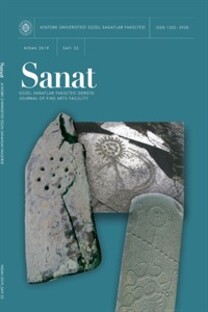Akköy'ün Dünü ve Bugünü
Past and Today of Akköy
Earthenware jug production and pottery are longstanding primitive production methods that come from very old ages. It is glad to know that earthenware production in Anatolia has not yet ended. However, it is very sad that the lost values of ceramic tradition have been increasing. Troy is the first city that shaped soil by using a potter's wheel in West Anatolia. However, it is interesting that this culture started to use potter's wheel long years after eastern regions. It is observed that traditional arts in Anatolia were affected negatively by the technological revolu tion in the beginning of the 20th century. Being a pottery and earthenware jug center in the 17th centu ry, Akcaalan village lost its importance, ceased to be a settlement area and left its position to Akkoy in Ezine district of Çanakkale.Factors such as the" start of water and refrigerator usage in houses and the increase in the number of pots made of synthetic materials in the recent periods affected earthenware jug production in this village very negatively. It was observed that only a few families in Akkoy are still making earthenware jug production according to the literature researches that were made without visiting the region. However, during the visit made to Akkoy, it was determined that only one family still carried on this tradition. Today, earthenware jug production in Akkoy village is being conducted in the building that is not used for educational purposes in Akkoy Primary School that consist of two buildings. When we enter the building, we see earthenware jugs, pots, ashtrays, candlesticks, an electrical turning lathe and a turret lathe in the production area. The kilns made of bricks and mud-bricks that are used for firing are in the garden of the school.Meanwhile, it is necessary to mention some technical difficulties. Supplying electricity for the building where the atelier is located from the adjoining school building and bringing water, which is one of the most important components for earthenware jug production, to the garden of the primary school by means of a hose are among the technical difficulties. Additionally, it is interesting that no market place has been found where the objects that are produced in the atelier can be sold. Those who know the place of the atelier come to the atelier in order to buy a few objects produced. However, the objects that are produced cannot be sold because of the lack of the required financial opportunities.Being the raw material of the earthenware jugs and other products in Akkoy, the clay is excavated from the field of a farmer and brought to the atelier in tractors. At the second stage, the clay is diluted and rested in tubs. Then, it is dehydrated and molded until it gains a plastic like consistency. Finally, it becomes ready to be processed. When we observe earthenware jug ateliers from past to present in terms of preserving traditional.cul-ture, we see that they lost their quality while their number decreased instead of increasing. In our geography, the traditional inheritance that is the foundation of our culture has been decreasing in every field of handicrafts and is about to disappear.For this reason, Faculties of Fine Arts and the institutions related to cultural inheritance should undertake significant responsibilities. Serious contributions can be made only by means of a union of the relevant departments of the Faculties of Fine Arts for a project related to this subject. The values of Anatolian culture can be transferred to the following generations as a result of recovering the conditions of such ateliers that continue traditional production and creating environments where the products can be revived.
___
- Bakla, Erdinç, "Essiz üç Çanakkale Seramiği", AntikaKültürü, 1993, sayı:l,
- Çizer, Sevim, "Antik Çağdan Günümüze Batı Anadolu Çömlekçiliği, Yaşayan Uzantısı Menemen", 4. ulusal el sanatları sempozyumu, 1985
- Gülsen, Yener, Akköy testiciliği ve sorunları, 2. ulusal el sanatları sempozyumu, İzmir, 1982
- Güner, Güngör, "Anadoluda yaşamakta olan İlkel Çömlekçilik", 2. ulusal el sanatları Sempozyumu, 1982
- Öney, Gönül, "Çanakkale' de Geç Devir Osmanlı Seramikleri", Bilim Birlik Başarı, 1982,sayı: 33
- Öney Gönül, "Türk Devri Çanakkale Seramikleri", Çan.Ser. Fabrikaları yay., 1971
- www.comu.edu.tr
- www.ezine.gov.tr
- ISSN: 1302-2938
- Yayın Aralığı: 2
- Başlangıç: 1999
- Yayıncı: Cordus
